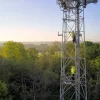Ofcom UK Digs Deeper into Sharing 6GHz for Mobile and WiFi

The UK telecoms regulator, Ofcom, has today published a new paper that sets out its options and vision for how the upper 6GHz radio spectrum band (6425 to 7125MHz) could potentially be released and then shared between both 5G mobile (mobile broadband) and Wi-Fi networks (e.g. home WiFi).
So far the regulator has already made the Lower part (5925 to 6425MHz) of the 6GHz band available for WiFi under the new WiFi 6E, WiFi 7 and future standards (here), yet the Upper part has remained the subject of some debate. Mobile operators want to harness it (licensed) to deliver faster 5G based mobile speeds, while others say it should go toward licence-exempt consumer WiFi. Meanwhile, existing users of the band (e.g. fixed services, satellite, radio astronomy and PMSE), seek protection.
Suffice to say, both sides of the debate have been able to field strong arguments and Ofcom has, thus far, opted not to pick a side. Instead, the regulator has been exploring the option of “hybrid sharing” (details), which could potentially enable, with some performance caveats (i.e. co-existence without causing interference is a challenge), the use of both Wi-Fi and mobile in the Upper 6GHz band.
Advertisement
The latest paper continues this by outlining the two possible approaches that could form part of such a “sharing framework“.
Proposals for Hybrid Sharing – Upper 6GHz Band
➤ Variable spectrum split.
Both Wi-Fi and mobile would be able to use any part of the band where the other is not deployed, but have sections of it they are prioritised in. This could be done by each technology transmitting a specific signal so they can sense and avoid each other.
➤ Indoor/outdoor split.
Wi-Fi routers tend to be indoors to serve a particular household, whereas mobile base stations are mostly located outdoors to provide coverage to a wider area. The band could be managed to prioritise the indoor use of Wi-Fi while also prioritising mobile use outdoors.
The paper itself is quite basic, but that does have the advantage of making it both easy and quick for anybody to read – somewhat of a rarity when it comes to regulatory paperwork.
Ofcom’s Statement
We are working with industry to develop a hybrid sharing framework and the necessary coexistence solutions. We are also working with other European regulators, with a technical report on this topic is scheduled to be published in 2025. Earlier this month, we welcomed a range of technology companies and European regulators to a workshop on this topic. The ideas discussed by the approximately 70 participants will help us further refine our thinking.
The UK Government’s Department for Science, Innovation and Technology is also funding several trials until March 2025 to explore new spectrum sharing techniques, which should provide insights for our work.
Crucially, Ofcom makes clear that it is still “too early to identify a single preferred approach” for handling the Upper 6GHz band, which is why they’re exploring two possible elements that could form part of the sharing framework, and some of the trade-offs that may be required. As above, the regulator also plans for a technical report on hybrid sharing to be published sometime in 2025, as well as a consultation on the precise mechanisms for authorising the Upper 6 GHz band.
In other words, it’s likely to be sometime in late 2025 or 2026 before we actually see some sort of practical outcome to all this, which largely reflects the fact that this is an evolving technological approach and one that needs to be proven before it can seriously be proposed for any kind of implementation. Not to mention that more consultations will be required before we reach that point.
Advertisement
Mark is a professional technology writer, IT consultant and computer engineer from Dorset (England), he also founded ISPreview in 1999 and enjoys analysing the latest telecoms and broadband developments. Find me on X (Twitter), Mastodon, Facebook, BlueSky, Threads.net and Linkedin.
« UK ISP Cuckoo Renews Deal with Payment Provider GoCardless





















































Just look at the amount of spectrum the four mobile network operators have combined.
This should absolutely all be reserved for our home networks, where with smart homes becoming more popular & more devices being connected, this would future proof home WiFi for many.
The four operators have [a mix of] 700mhz, 800mhz, 900mhz, 1400mhz, 1800, 1700, 1900, 2100, 2600, 3400 – 3900. Plus they are waiting on the mmWave auction. They will even eventually get the bands that DTTV /Freeview use – 600mhz – come 2035/2040.
Here here!
But OFCOM can’t make money from WiFi.
Where? Where?
Fully expect the spectrum to go to the mobile operators, as that’s where the potential money is, even though it really should just go to Wi-Fi.
Wi-Fi is in extreme demand and there’s Wi-Fi in just about every building in the country these days, most of it unfortunately is overlapping with neighbouring networks.
Whilst WiFi is useful it’s way over used and abused. HMG should be mandating new build houses be (flood) wired with LAN cabling (Cat 6/7), the existing housing stock encouraged to install LAN cabling and BAN mesh systems. Either that or mandate only wide area WiFi networks and ban one system per house as so many people have at present.
Were I live* I can ‘see’ 18 WifFi usable systems. Wifi I pay for in my home to my Tablet and Mobile is very inconsistent; sometimes moving from one end of the sofa to the other and the Wifi will drop out. There is so much interference that the upload and download speeds are low.
*rural village location
18 is not that big of a deal (and its likely that some of those are just additional networks on the same router, eg EE Wi-Fi, which won’t add much extra interference especially if not in use). I’d wonder if there is something wrong with your equipment.
Ultimately this spectrum is licence-exempt and anyone is free to use it as they see fit (with equipment that is certified to meet regulations). This will be why the mobile networks probably aren’t gagging to utilise it because it’s so unpredictable.
These higher frequencies are useless for longer range transmission so in reality I think they should go for home networking rather than the mobile networks. As full fibre is coming to more and more properties, do we really need such high capacity mobile connections?